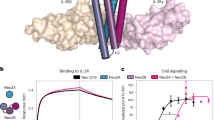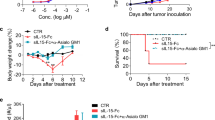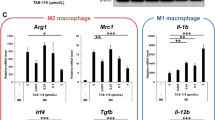Abstract
The clinical use of tumor necrosis factor α (TNF) as an anticancer drug is limited to local treatments because of its dose-limiting systemic toxicity. We show here that murine TNF fused with CNGRC peptide (NGR-TNF), an aminopeptidase N (CD13) ligand that targets activated blood vessels in tumors, is 12–15 times more efficient than murine TNF in decreasing the tumor burden in lymphoma and melanoma animal models, whereas its toxicity is similar. Similarly, human NGR-TNF induced stronger antitumor effects than human TNF, even with 30 times lower doses. Coadministration of murine NGR-TNF with a CNGRC peptide or an anti-CD13 antibody markedly decreased its antitumor effects. Tumor regression, induced by doses of murine NGR-TNF lower than the LD50, was accompanied by protective immunity. In contrast, no cure was induced by TNF at any dose. These results suggest that targeted delivery of TNF to CD13 may enhance its immunotherapeutic properties. Moreover, these findings reveal the potential of tumor homing peptides to generate a new class of recombinant cytokines that compared to immunocytokines have a simpler structure, could be easier to produce and are potentially less immunogenic.
This is a preview of subscription content, access via your institution
Access options
Subscribe to this journal
Receive 12 print issues and online access
$209.00 per year
only $17.42 per issue
Buy this article
- Purchase on Springer Link
- Instant access to full article PDF
Prices may be subject to local taxes which are calculated during checkout






Similar content being viewed by others
References
Fiers, W. Biologic therapy with TNF: preclinical studies In Biologic therapy of cancer: principles and practice. (eds DeVita, V., Hellman, S. & Rosenberg, S.) 295–327 (J.B. Lippincott, Philadelphia; 1995).
Carswell, E.A. et al. An endotoxin-induced serum factor that causes necrosis of tumors . Proc. Natl. Acad. Sci. USA 72, 3666– 3670 (1975).
Fraker, D.L., Alexander, H.R. & Pass, H.I. Biologic therapy with TNF: systemic administration and isolation perfusion. In Biologic therapy of cancer: principles and practice. (eds DeVita V., Hellman, S. & Rosenberg, S.) 329–345 (J.B. Lippincott, Philadelphia; 1995).
Lienard, D., Ewalenko, P., Delmotte, J.J., Renard, N. & Lejeune, F.J. High-dose recombinant tumor necrosis factor alpha in combination with interferon gamma and melphalan in isolation perfusion of the limbs for melanoma and sarcoma. J. Clin. Oncol. 10, 52–60 (1992).
Eggermont, A.M. et al. Isolated limb perfusion with high-dose tumor necrosis factor-alpha in combination with interferon-gamma and melphalan for nonresectable extremity soft tissue sarcomas: a multicenter trial. J. Clin. Oncol. 14, 2653–2665 (1996).
Fraker, D.L., Alexander, H.R., Andrich, M. & Rosenberg, S.A. Treatment of patients with melanoma of the extremity using hyperthermic isolated limb perfusion with melphalan, tumor necrosis factor, and interferon gamma: results of a tumor necrosis factor dose-escalation study. J. Clin. Oncol. 14, 479–489 ( 1996).
Alexander, H.R. Jr. et al. Isolated hepatic perfusion with tumor necrosis factor and melphalan for unresectable cancers confined to the liver. J. Clin. Oncol. 16, 1479–1489 (1998).
Corti, A. & Marcucci, F. Tumour necrosis factor: strategies for improving the therapeutic index. J. Drug Targ. 5, 403–413 (1998).
Gasparri, A. et al. Tumor pretargeting with avidin improves the therapeutic index of biotinylated tumor necrosis factor alpha in mouse models. Cancer Res. 59, 2917–2923 ( 1999).
Nawroth, P. et al. Tumor necrosis factor/cachectin-induced intravascular fibrin formation in meth A fibrosarcomas. J. Exp. Med. 168, 637–647 (1988).
Nawroth, P.P. & Stern, D.M. Modulation of endothelial cell hemostatic properties by tumor necrosis factor. J. Exp. Med. 163, 740–745 ( 1986).
Palladino, M.A. Jr. et al. Characterization of the antitumor activities of human tumor necrosis factor-alpha and the comparison with other cytokines: induction of tumor-specific immunity. J. Immunol. 138 , 4023–4032 (1987).
Clauss, M. et al. A polypeptide factor produced by fibrosarcoma cells that induces endothelial tissue factor and enhances the procoagulant response to tumor necrosis factor/cachectin . J. Biol. Chem. 265, 7078– 7083 (1990).
Arap, W., Pasqualini, R. & Ruoslahti, E. Cancer treatment by targeted drug delivery to tumor vasculature in a mouse model. Science 279, 377–380 (1998).
Pasqualini, R., Koivunen, E. & Ruoslahti, E. Alpha v integrins as receptors for tumor targeting by circulating ligands. Nat. Biotechnol. 15, 542–546 (1997).
Koivunen, E. et al. Tumor targeting with a selective gelatinase inhibitor. Nat. Biotechnol. 17, 768–774 (1999).
Pasqualini, R. et al. Aminopeptidase N is a receptor for tumor-homing peptides and a target for inhibiting angiogenesis. Cancer Res. 60, 722–727 (2000).
Smith, R.A. & Baglioni, C. The active form of tumor necrosis factor is a trimer. J. Biol. Chem. 262 , 6951–6954 (1987).
Moro, M. et al. Tumor cell targeting with antibody–avidin complexes and biotinylated tumor necrosis factor alpha. Cancer Res. 57, 1922–1928 (1997).
Stryhn Hansen, A., Noren, O., Sjostrom, H. & Werdelin, O. A mouse aminopeptidase N is a marker for antigen-presenting cells and appears to be co-expressed with major histocompatibility complex class II molecules . Eur. J. Immunol. 23, 2358– 2364 (1993).
Taylor, A. Aminopeptidases: structure and function. FASEB J. 7 , 290–298 (1993).
Shipp, M.A. & Look, A.T. Hematopoietic differentiation antigens that are membrane-associated enzymes: cutting is the key. Blood 82, 1052–1070 ( 1993).
Talmadge, J.E., Tribble, H.R., Pennington, R.W., Phillips, H. & Wiltrout, R.H. Immunomodulatory and immunotherapeutic properties of recombinant gamma-interferon and recombinant tumor necrosis factor in mice. Cancer Res. 47, 2563–2570 (1987).
Pfizenmaier, K., Scheurich, P., Schluter, C. & Kronke, M. Tumor necrosis factor enhances HLA-A,B,C and HLA-DR gene expression in human tumor cells. J. Immunol. 138, 975– 980 (1987).
Asher, A.L. et al. Murine tumor cells transduced with the gene for tumor necrosis factor-alpha. Evidence for paracrine immune effects of tumor necrosis factor against tumors . J. Immunol. 146, 3227– 3234 (1991).
Schraffordt Koops, H. et al. Hyperthermic isolated limb perfusion with tumour necrosis factor and melphalan as treatment of locally advanced or recurrent soft tissue sarcomas of the extremities. Radiother. Oncol. 48, 1–4 (1998).
Lienard, D., Lejeune, F.J. & Ewalenko, P. In transit metastases of malignant melanoma treated by high dose rTNF alpha in combination with interferon-gamma and melphalan in isolation perfusion. World J. Surg. 16, 234–240 (1992).
Hill, S. et al. Low-dose tumour necrosis factor alpha and melphalan in hyperthermic isolated limb perfusion. Br. J. Surg. 80, 995– 997 (1993).
Eggermont, A.M. et al. Isolated limb perfusion with tumor necrosis factor and melphalan for limb salvage in 186 patients with locally advanced soft tissue extremity sarcomas. The cumulative multicenter European experience. Ann. Surg. 224, 756–765 ( 1996).
Corti, A. et al. Tumor targeting with biotinylated tumor necrosis factor alpha: structure–activity relationships and mechanism of action on avidin pretargeted tumor cells. Cancer Res. 58, 3866–3872 (1998).
Ljunggren, H.G. & Karre, K. Host resistance directed selectively against H-2-deficient lymphoma variants. Analysis of the mechanism. J. Exp. Med. 162, 1745– 1759 (1985).
Celik, C., Lewis, D.A. & Goldrosen, M.H. Demonstration of immunogenicity with the poorly immunogenic B16 melanoma. Cancer Res. 43, 3507– 3510 (1983).
Pennica, D., Hayflick, J.S., Bringman, T.S., Palladino, M.A. & Goeddel, D.V. Cloning and expression in Escherichia coli of the cDNA for murine tumor necrosis factor. Proc. Natl. Acad. Sci. USA 82, 6060 –6064 (1985).
Corti, A., Poiesi, C., Merli, S. & Cassani, G. Tumor necrosis factor (TNF) alpha quantification by ELISA and bioassay: effects of TNF alpha-soluble TNF receptor (p55) complex dissociation during assay incubations. J. Immunol. Methods 177, 191–198 (1994).
Gasparri, A. et al. Chromogranin A fragments modulate cell adhesion. Identification and characterization of a pro-adhesive domain. J. Biol. Chem. 272, 20835–20843 (1997).
Acknowledgements
This work was supported by Associazione Italiana Ricerca sul Cancro (AIRC). We thank Renata Pasqualini for advice and critical review, Barbara Colombo for the protein characterization and endotoxin analysis, and A.G. Siccardi and P. Dellabona for helpful discussions.
Author information
Authors and Affiliations
Corresponding author
Rights and permissions
About this article
Cite this article
Curnis, F., Sacchi, A., Borgna, L. et al. Enhancement of tumor necrosis factor α antitumor immunotherapeutic properties by targeted delivery to aminopeptidase N (CD13). Nat Biotechnol 18, 1185–1190 (2000). https://doi.org/10.1038/81183
Received:
Accepted:
Issue Date:
DOI: https://doi.org/10.1038/81183
This article is cited by
-
A novel aminopeptidase N/CD13 inhibitor selectively targets an endothelial form of CD13 after coupling to proteins
Cellular and Molecular Life Sciences (2024)
-
Current and emerging therapies for primary central nervous system lymphoma
Biomarker Research (2021)
-
CD13 orients the apical-basal polarity axis necessary for lumen formation
Nature Communications (2021)
-
Enhancing CAR-T cell efficacy in solid tumors by targeting the tumor microenvironment
Cellular & Molecular Immunology (2021)
-
A single nucleotide mutation drastically increases the expression of tumor-homing NGR-TNFα in the E. coli M15-pQE30 system by improving gene transcription
Applied Microbiology and Biotechnology (2021)



